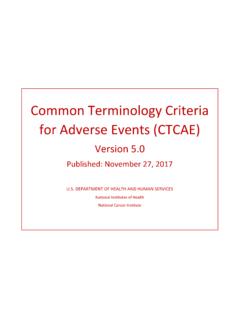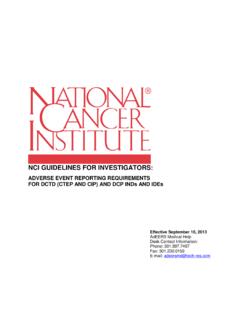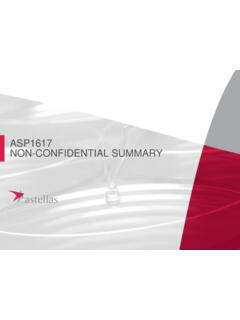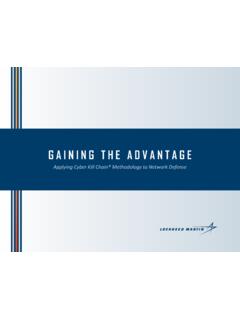Transcription of New response evaluation criteria in solid tumours: Revised ...
1 New response evaluation criteria in solid tumours: Revised RECIST guideline (version ) Eisenhauera,*, P. Therasseb, J. Bogaertsc, Schwartzd, D. Sargente, R. Fordf,J. Danceyg, S. Arbuckh, S. Gwytheri, M. Mooneyg, L. Rubinsteing, L. Shankarg, L. Doddg,R. Kaplanj, D. Lacombec, J. VerweijkaNational Cancer Institute of Canada Clinical Trials Group, 10 Stuart Street, Queen s University, Kingston, ON, CanadabGlaxoSmithKline Biologicals, Rixensart, BelgiumcEuropean Organisation for Research and Treatment of Cancer, Data Centre, Brussels, BelgiumdMemorial Sloan Kettering Cancer Center, New York, NY, USAeMayo Clinic, Rochester, MN, USAfRadPharm, Princeton, NJ, USAgDivision of Cancer Treatment and Diagnosis, National Cancer Institute, Bethesda, MD, USAhSchering-Plough, Kenilworth, NJ, USAiEast Surrey Hospital, Redhill, Surrey, UKjNational Cancer Research Network, Leeds, UKkErasmus University Medical Center, Rotterdam, The NetherlandsARTICLE INFOA rticle history:Received 17 October 2008 Accepted 29 October 2008 Keywords.
2 response criteriaSolid tumoursGuidelinesABSTRACTB ackground:Assessment of the change in tumour burden is an important feature of theclinical evaluation of cancer therapeutics: both tumour shrinkage (objective response )and disease progression are useful endpoints in clinical trials. Since RECISTwas publishedin 2000, many investigators, cooperative groups, industry and government authorities haveadopted these criteria in the assessment of treatment outcomes. However, a number ofquestions and issues have arisen which have led to the development of a Revised RECIST guideline (version ). Evidence for changes, summarised in separate papers in this specialissue, has come from assessment of a large data warehouse (>6500 patients), simulationstudies and literature of Revised RECIST :Major changes include:Number of lesions to be assessed: basedon evidence from numerous trial databases merged into a data warehouse for analysis pur-poses, the number of lesions required to assess tumour burden for response determinationhas been reduced from a maximum of 10 to a maximum of five total (and from five to twoper organ, maximum).
3 Assessment of pathological lymphnodes is now incorporated: nodeswith ashortaxis ofP15 mm are considered measurable and assessable as target short axis measurement should be included in the sum of lesions in calculation oftumour response . Nodes that shrink to <10 mm short axis are considered of responseis required for trials with response primary endpoint but is no longerrequired in randomised studies since the control arm serves as appropriate means of inter-pretation of progressionis clarified in several aspects: in addition to the previ-ous definition of progression in target disease of 20% increase in sum, a 5 mm absoluteincrease is now required as well to guard against over calling PD when the total sum is very0959-8049/$ - see front matter 2008 Elsevier Ltd.
4 All rights *Corresponding author:Tel.: +1 613 533 6430; fax: +1 613 533 Eisenhauer).EUROPEANJOURNALOFCANCER45(20 09)228 247available at homepage: Furthermore, there is guidance offered on what constitutes unequivocal progres-sion of non-measurable/non-target disease, a source of confusion in the original RECIST guideline. Finally, a section on detection of new lesions, including the interpretation ofFDG-PET scan assessment is guidance: the Revised RECIST includes anew imaging appendix with updated recommendations on the optimal anatomical assess-ment of work:A key question considered by the RECIST Working Group in developing was whether it was appropriate to move from anatomic unidimensional assessment oftumour burden to either volumetric anatomical assessment or to functional assessmentwith PET or MRI.
5 It was concluded that, at present, there is not sufficient standardisationor evidence to abandon anatomical assessment of tumour burden. The only exception tothis is in the use of FDG-PET imaging as an adjunct to determination of progression. Asis detailed in the final paper in this special issue, the use of these promising newerapproaches requires appropriate clinical validation studies. 2008 Elsevier Ltd. All rights History of RECIST criteriaAssessment of the change in tumour burden is an importantfeature of the clinical evaluation of cancer therapeutics. Bothtumour shrinkage (objective response ) and time to the devel-opment of disease progression are important endpoints incancer clinical trials. The use of tumour regression as theendpoint for phase II trials screening new agents for evi-dence of anti-tumour effect is supported by years of evi-dence suggesting that, for many solid tumours, agentswhich produce tumour shrinkage in a proportion of patientshave a reasonable (albeit imperfect) chance of subsequentlydemonstrating an improvement in overall survival or othertime to event measures in randomised phase III studies (re-viewed in[1 4]).
6 At the current time objective response car-ries with it a body of evidence greater than for any otherbiomarker supporting its utility as a measure of promisingtreatment effect in phase II screening trials. Furthermore,at both the phase II and phase III stage of drug development,clinical trials in advanced disease settings are increasinglyutilising time to progression (or progression-free survival)as an endpoint upon which efficacy conclusions are drawn,which is also based on anatomical measurement of , both of these tumour endpoints, objective re-sponse and time to disease progression, are useful only ifbased on widely accepted and readily applied standard crite-ria based on anatomical tumour burden. In 1981 the WorldHealth Organisation (WHO) first published tumour responsecriteria, mainly for use in trials where tumour response wasthe primary endpoint .
7 The WHO criteria introduced the con-cept of an overall assessment of tumour burden by summingthe products of bidimensional lesion measurements anddetermined response to therapy by evaluation of change frombaseline while on , in the decades thatfollowed their publication, cooperative groups and pharma-ceutical companies that used the WHO criteria often modi-fied them to accommodate new technologies or to addressareas that were unclear in the original document. This ledto confusion in interpretation of trial results6and in fact,the application of varying response criteria was shown to leadto very different conclusions about the efficacy of the response to these problems, an InternationalWorking Party was formed in the mid 1990s to standardiseand simplify response criteria .
8 New criteria , known as RECIST( response evaluation criteria in solid Tumours), were pub-lished in features of the original RECIST includedefinitions of minimum size of measurable lesions, instruc-tions on how many lesions to follow (up to 10; a maximumfive per organ site), and the use of unidimensional, ratherthan bidimensional, measures for overall evaluation of tu-mour burden. These criteria have subsequently been widelyadopted by academic institutions, cooperative groups, andindustry for trials where the primary endpoints are objectiveresponse or progression. In addition, regulatory authoritiesaccept RECIST as an appropriate guideline for Why update RECIST?Since RECISTwas published in 2000, many investigators haveconfirmed in prospective analyses the validity of substitutingunidimensional for bidimensional (and even three-dimen-sional)-based criteria (reviewed in[9]).
9 With rare exceptions( mesothelioma), the use of unidimensional criteria seemsto perform well in solid tumour phase II , a number of questions and issues have arisenwhich merit answers and further clarity. Amongst theseare whether fewer than 10 lesions can be assessed withoutaffecting the overall assigned response for patients (or theconclusion about activity in trials); how to apply RECIST inrandomised phase III trials where progression, not response ,is the primary endpoint particularly if not all patients havemeasurable disease; whether or how to utilise newer imag-ing technologies such as FDG-PET and MRI; how to handleassessment of lymph nodes; whether response confirmationis truly needed; and, not least, the applicability of RECIST intrials of targeted non-cytotoxic drugs.
10 This revision of theRECIST guidelines includes updates that touch on all (2009)228 Process of RECIST developmentThe RECIST Working Group, consisting of clinicians withexpertise in early drug development from academic researchorganisations, government and industry, together with imag-ing specialists and statisticians, has met regularly to set theagenda for an update to RECIST, determine the evidenceneeded to justify the various changes made, and to reviewemerging evidence. A critical aspect of the revision processwas to create a database of prospectively documented solidtumour measurement data obtained from industry and aca-demic group trials. This database, assembled at the EORTCData Centre under the leadership of Jan Bogaerts and PatrickTherasse (co-authors of this guideline), consists of >6500 pa-tients with >18,000 target lesions and was utilised to investi-gate the impact of a variety of questions ( number oftarget lesions required, the need for response confirmation,and lymph node measurement rules) on response and pro-gression-free survival outcomes.










